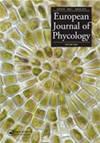Taxonomy and species diversity of Padina (Dictyotales, Phaeophyceae) from the Indo-Pacific with the description of two new species
IF 1.7
4区 生物学
Q2 MARINE & FRESHWATER BIOLOGY
引用次数: 2
Abstract
ABSTRACT Taxonomy, species diversity, and geographical distribution of the marine brown algal genus Padina (Dictyotales, Phaeophyceae) from tropical South-East Asian waters were investigated through a combination of morphological and molecular analyses. The study presents a new schematic diagram showing a suite of morphological characters including thallus hairline structures that are useful for species delineation in the genus. This study also revealed two new species from Myanmar, P. gracilis sp. nov. and P. lata sp. nov. based on molecular and morphological data. P. gracilis is characterised by a 2-layered thallus, thin hairlines on both surfaces of the thallus at equal distances, non-indusiate reproductive sori distally very close to the hairlines on the inferior surface, and the presence of Vaughaniella stage. P. lata is characterized by a 2–4-layered tiny thallus, broad hairlines located only on the inferior thallus surface, non-indusiate reproductive sori abutting the hairlines on the inferior surface and irregularly spreading on the superior surface, and the presence of Vaughaniella stage. This study also revealed new distributional records for four Padina species: P. okinawaensis from Myanmar and P. fasciata, P. ryukyuana and P. terricolor from the Philippines. These findings point to elevated species diversity in central Indo-Pacific waters. This study confirmed that most of the Padina species in the Pacific regions are showing overlapping distribution across the regions, in contrast to species from the Indian Ocean, which tend to be confined to specific localities.印太帕迪纳的分类学和物种多样性及两新种描述
摘要采用形态学和分子分析相结合的方法对热带东南亚海域褐藻Padina属(dictyotale, Phaeophyceae)的分类、物种多样性和地理分布进行了研究。该研究提出了一个新的示意图,显示了一套形态学特征,包括菌体发际线结构,有助于在属中划分物种。本研究还根据分子和形态资料发现了两个缅甸新种:P. gracilis sp. nov和P. lata sp. nov。薄壁菌的特点是2层菌体,菌体表面细发际线在等距处,非工业生殖菌远端非常接近下表面的发际线,并且存在Vaughaniella期。该菌具有2 - 4层的小菌体,较宽的发际线仅位于下菌体表面,非工业化生殖菌靠近下菌体的发际线,在上菌体表面不规则分布,存在Vaughaniella期。本研究还发现了缅甸的P. okinawaensis和菲律宾的P. fasciata、P. ryukyuana和P. terricolor四种帕丁那属植物的新分布记录。这些发现表明,印度-太平洋中部水域的物种多样性有所提高。这项研究证实,太平洋地区的大多数帕迪纳物种在整个地区表现出重叠分布,而印度洋的物种往往局限于特定的地方。
本文章由计算机程序翻译,如有差异,请以英文原文为准。
求助全文
约1分钟内获得全文
求助全文
来源期刊

European Journal of Phycology
生物-海洋与淡水生物学
CiteScore
4.80
自引率
4.20%
发文量
37
审稿时长
>12 weeks
期刊介绍:
The European Journal of Phycology is an important focus for the activities of algal researchers all over the world. The Editors-in-Chief are assisted by an international team of Associate Editors who are experts in the following fields: macroalgal ecology, microalgal ecology, physiology and biochemistry, cell biology, molecular biology, macroalgal and microalgal systematics, applied phycology and biotechnology. The European Journal of Phycology publishes papers on all aspects of algae, including cyanobacteria. Articles may be in the form of primary research papers and reviews of topical subjects.
The journal publishes high quality research and is well cited, with a consistently good Impact Factor.
 求助内容:
求助内容: 应助结果提醒方式:
应助结果提醒方式:


